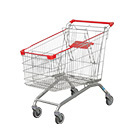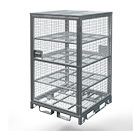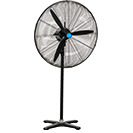Warehouse Trolleys - Buyer's Guide
Date Posted:29 August 2024
Whether you’re in logistics, manufacturing, or retail, the right trolley will streamline your processes, reduce physical strain on your workers, and contribute to a more organised and productive workspace.
Warehouse trolleys are crucial tools in logistics, manufacturing, and retail operations, designed to transport goods efficiently within a warehouse environment. Selecting the right warehouse trolley can significantly impact productivity, safety, and operational efficiency. This guide will provide you with essential insights into the types of warehouse trolleys available, key features to consider, and how to choose the best trolley for your needs.
1. Why Are Warehouse Trolleys Important?
Warehouse trolleys serve as the backbone of material handling within warehouses and distribution centres. Their importance lies in:
- Efficiency: Trolleys streamline the movement of goods, reducing the time spent on manual handling and increasing the speed of operations.
- Safety: They minimise the physical strain on workers by allowing them to transport heavy loads without carrying them manually, reducing the risk of injury.
- Organisation: Trolleys help maintain an organised workflow by providing a dedicated space for transporting and storing items.
2. Types of Warehouse Trolleys
There are various types of warehouse trolleys, each suited to different tasks within a warehouse:
- Platform Trolleys: These trolleys feature a flat, open platform on wheels, ideal for transporting large or bulky items. They come in various sizes and weight capacities, making them versatile for different warehouse needs.
- Cage Trolleys: Cage trolleys are enclosed on all sides with wire mesh, providing secure transportation of goods that might otherwise fall off a platform trolley. They are commonly used for transporting smaller items or goods that need extra protection.
- Shelf Trolleys: Designed with multiple shelves, these trolleys are perfect for picking and transporting smaller items. They are often used in warehouses where order picking is a frequent task.
- Heavy-Duty Trolleys: Built to handle particularly heavy loads, heavy-duty trolleys are reinforced with stronger materials and larger wheels, making them suitable for industrial applications where durability is essential.
- Order Picking Trolleys: Specifically designed for picking items from shelves and transporting them to packing areas, these trolleys often include features like bins or baskets to organise items during the picking process.
3. Key Features to Consider
When selecting a warehouse trolley, consider the following features to ensure it meets your operational needs:
- Load Capacity: The trolley’s load capacity is one of the most important factors. Ensure the trolley can handle the maximum weight you’ll need to transport without compromising safety or manoeuvrability.
- Material: The material of the trolley impacts its durability and suitability for specific environments. Steel trolleys offer strength and durability, ideal for heavy loads. Aluminium trolleys are lightweight and resistant to corrosion, making them suitable for environments where the trolley might be exposed to moisture. Plastic trolleys, while lighter, are suitable for lighter loads and environments where hygiene is important.
- Wheels and Mobility: The wheels play a crucial role in the trolley’s manoeuvrability. Swivel wheels allow for easy turning and movement in tight spaces, while larger wheels can help navigate uneven surfaces. For trolleys that will be stationary for periods, look for models with lockable wheels.
- Ergonomic Design: An ergonomic design can reduce physical strain on workers. Look for trolleys with comfortable handle heights, easy-to-grip surfaces, and features that reduce the effort needed to move heavy loads.
- Size and Dimensions: The size of the trolley should be compatible with the dimensions of your warehouse aisles, doorways, and storage areas. A trolley that’s too large might be difficult to manoeuvre in tight spaces, while one that’s too small might not meet your load capacity needs.
- Additional Features: Some trolleys come with additional features like brakes, folding mechanisms for easy storage, or shelves and compartments for better organisation. Consider these features if they align with your specific needs.
4. Applications in the Warehouse Environment
Warehouse trolleys are versatile and can be used in various settings, including:
- Logistics and Distribution: Trolleys are essential for transporting goods between different areas of the warehouse, such as from receiving docks to storage areas or from storage to dispatch.
- Manufacturing: In manufacturing settings, trolleys are used to move raw materials, components, and finished products between different stages of the production process.
- Retail Warehousing: For retail operations, trolleys help in the efficient picking and packing of orders, particularly during peak periods where speed and accuracy are critical.
- E-commerce Fulfilment: In e-commerce warehouses, trolleys are used to pick items for customer orders, often involving multi-tiered trolleys that can hold multiple orders at once.
5. Cost and Value Considerations
When purchasing a warehouse trolley, consider both the initial cost and the long-term value. A higher-quality trolley may require a larger upfront investment but can save money in the long run by offering greater durability and requiring fewer replacements. Assess your specific needs, such as load capacity and frequency of use, to determine the most cost-effective option.
Whether you’re in logistics, manufacturing, or retail, the right trolley will streamline your processes, reduce physical strain on your workers, and contribute to a more organised and productive workspace.






















































































 Trolleys & Hand Trucks
Trolleys & Hand Trucks Cage Trolleys
Cage Trolleys Cleaning Carts & Trolleys
Cleaning Carts & Trolleys Construction Trolleys
Construction Trolleys Custom Trolleys
Custom Trolleys Hand Trucks & Dollies
Hand Trucks & Dollies Laundry/Linen Trolleys
Laundry/Linen Trolleys Lifting Trolleys
Lifting Trolleys Order Picking Trolleys
Order Picking Trolleys Panel Cart Trolleys
Panel Cart Trolleys Platform Trolleys
Platform Trolleys Powered Trolleys
Powered Trolleys Shelf & Tiered Trolleys
Shelf & Tiered Trolleys Shopping Trolleys
Shopping Trolleys Stainless Steel Trolleys
Stainless Steel Trolleys Tool Trolleys
Tool Trolleys Utility & Service Carts
Utility & Service Carts Lifting & Handling Equipment
Lifting & Handling Equipment Forklift Attachments
Forklift Attachments Jib Attachments
Jib Attachments Lifting Hoists & Pallet Hooks
Lifting Hoists & Pallet Hooks Load Skates & Tow Tugs
Load Skates & Tow Tugs Manual Stackers & Lifters
Manual Stackers & Lifters Pallet Jacks
Pallet Jacks Pallet Lifters
Pallet Lifters Pallet Rotators & Dispenser
Pallet Rotators & Dispenser Powered Pallet Trucks & Electric Lifters
Powered Pallet Trucks & Electric Lifters Scissor Lift Trolleys and Tables
Scissor Lift Trolleys and Tables Conveyor Equipment
Conveyor Equipment Conveyor Frames & Stands
Conveyor Frames & Stands Roller & Skate Conveyors
Roller & Skate Conveyors Ladders & Access Equipment
Ladders & Access Equipment Container & Yard Ramps
Container & Yard Ramps Ladders & Step Stools
Ladders & Step Stools Work Platforms & Crane Cages
Work Platforms & Crane Cages Drum Handling Equipment
Drum Handling Equipment Drum Storage & Bunding
Drum Storage & Bunding Drum Trolleys & Lifters
Drum Trolleys & Lifters Forklift Drum Handling
Forklift Drum Handling Waste Handling & Bins
Waste Handling & Bins Bin Lifters & Tippers
Bin Lifters & Tippers Plastic Waste & Wheelie Bins
Plastic Waste & Wheelie Bins Steel Waste & Tipping Bins
Steel Waste & Tipping Bins Waste Carts
Waste Carts Dangerous Goods Storage & Spillage
Dangerous Goods Storage & Spillage Aerosol Cans Storage Cages
Aerosol Cans Storage Cages Bunded Pallets & Storage
Bunded Pallets & Storage Corrosive Goods Storage Cabinets
Corrosive Goods Storage Cabinets DG Storage & Trolleys
DG Storage & Trolleys Flammable Liquid Cabinets
Flammable Liquid Cabinets Forklift Gas Storage Cages
Forklift Gas Storage Cages Site Storage
Site Storage Spill Kits
Spill Kits Shelving & Storage Equipment
Shelving & Storage Equipment Stillage & Transport Cages
Stillage & Transport Cages 750 Series Cage Configurations
750 Series Cage Configurations Heavy Duty Cabinets
Heavy Duty Cabinets Heavy Duty Shelving
Heavy Duty Shelving Mega Bins & Pallets
Mega Bins & Pallets Packing & Workbenches
Packing & Workbenches Parts Trays & Stor-Pak Bins
Parts Trays & Stor-Pak Bins Pegboard & Louvre Panels
Pegboard & Louvre Panels Plastic Bins & Crates
Plastic Bins & Crates Plastic Handling Solutions Bins
Plastic Handling Solutions Bins Plastic Pallets
Plastic Pallets Stack & Nest Bins
Stack & Nest Bins Pallet Racking Accessories
Pallet Racking Accessories Workplace Equipment
Workplace Equipment Modular Workbenches
Modular Workbenches Electric Height-Adjustable Workbenches
Electric Height-Adjustable Workbenches Floor Matting
Floor Matting General Workplace Equipment
General Workplace Equipment Industrial Weighing Scales
Industrial Weighing Scales Packaging Machinery
Packaging Machinery Stationery Cupboards
Stationery Cupboards Storage and Stillage Cages
Storage and Stillage Cages Tool Trolleys
Tool Trolleys Tooling Cabinets
Tooling Cabinets Workshop Fans and Coolers
Workshop Fans and Coolers Safety Barriers, PPE & Signage
Safety Barriers, PPE & Signage Barriers & Bollards
Barriers & Bollards First Aid Equipment
First Aid Equipment Gloves, Knives and PPE
Gloves, Knives and PPE Signage
Signage Cleaning & Site Supplies
Cleaning & Site Supplies Cleaning Equipment
Cleaning Equipment Cleaning Trolleys
Cleaning Trolleys Rubbish Bins
Rubbish Bins Signs & Traffic Supplies
Signs & Traffic Supplies Construction Equipment
Construction Equipment Construction Trolleys
Construction Trolleys Waste Handling
Waste Handling General Site Equipment
General Site Equipment Concrete Equipment
Concrete Equipment Site Storage
Site Storage Lifting Equipment
Lifting Equipment










